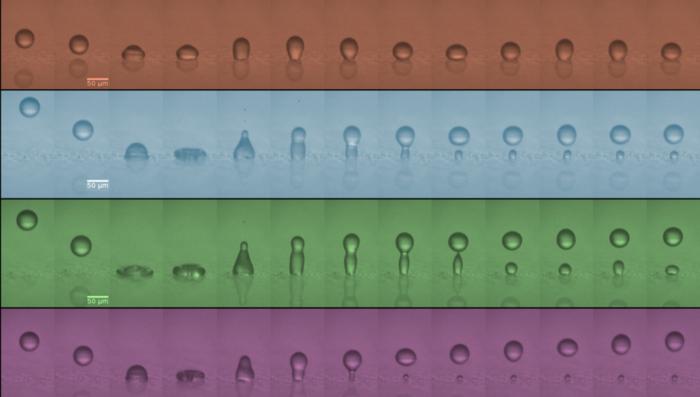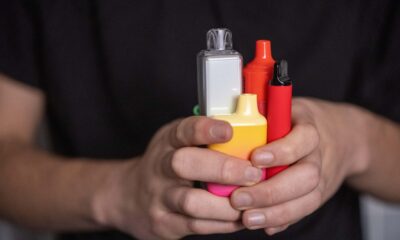Science
Physicists Unravel Complex Dynamics of Droplets on Hydrophobic Surfaces

Research from physicists in the UK and the Netherlands has shed light on the complex interactions between fast-moving droplets and hydrophobic surfaces. This study is particularly relevant for applications such as pesticide spraying on crops and understanding the spread of disease-causing aerosols.
According to the findings, the behavior of a droplet upon landing is not solely determined by its speed. The researchers discovered that droplets can either stick or bounce based on a combination of factors, including droplet velocity, size, and the properties of the surface it strikes. “If the droplet moves too slowly, it sticks,” explains Jamie McLauchlan, a PhD student at the University of Bath. “Too fast, and it sticks again. Only in between is bouncing possible.” This insight challenges the conventional expectation that faster droplets should always bounce off water-repelling surfaces.
The research team, which includes Adam Squires from Bath and Anton Souslov from the University of Cambridge, also identified a critical size effect. They found that droplets below a certain size cannot bounce, regardless of their speed. This limitation stems from the viscosity of the liquid, which prevents tiny droplets from detaching once they land.
The motivation for this research intensified during the COVID-19 pandemic, when the behavior of airborne respiratory droplets became a significant focus. McLauchlan notes, “We wanted to push this knowledge to smaller sizes of micrometre droplets and faster speeds, where higher surface-to-volume ratios make interfacial effects critical.”
To investigate these dynamics, McLauchlan and his colleagues utilized advanced technology, including a high-speed camera capable of slowing down motion by a factor of 100,000. They produced droplets using piezoelectric generators that dispense fluid through tiny nozzles measuring just 30 microns. “These dispensers are highly temperamental,” McLauchlan cautions. “They can become blocked easily by dust and fibers, making experiments delicate to plan and run.”
The researchers successfully created and recorded droplets ranging from 30 to 50 μm in diameter, impacting hydrophobic surfaces at speeds between 1 and 10 m/s. They compared their experimental results with calculations based on a mathematical model that treats the droplets like tiny springs, factoring in surface stickiness, droplet viscosity, and surface tension.
Previous studies have indicated that on perfect non-wetting surfaces, the ability to bounce does not depend on velocity. In contrast, the new research broadens the understanding of droplet behavior on various hydrophobic surfaces, revealing that bouncing occurs due to a delicate balance of kinetic energy, viscous dissipation, and interfacial energies. “Our work has explored a broader range of hydrophobic surfaces,” McLauchlan states, highlighting the relevance of their findings for aerosol science.
The implications of this research extend beyond academic curiosity. By linking droplet behavior to velocity, size, and surface properties, the new framework could enhance the engineering of microdroplets for specific applications. In agriculture, for instance, understanding the interaction between spray velocities and plant surfaces could lead to improved efficiency in crop spraying.
Moreover, the study offers insights into the dynamics of airborne diseases. When exhaled droplets encounter surfaces indoors, those that stick are removed from the air, reducing the chance of disease transmission. Conversely, droplets that bounce remain airborne, contributing to potential disease spread. McLauchlan points out that quantifying these processes can lead to better models of airborne pathogen concentrations.
In healthcare settings, coatings could be designed to either inhibit or promote bouncing, depending on the desired mode of transmission. This research opens avenues for designing environments that either contain or allow airborne pathogens to disperse.
Looking ahead, the researchers plan to expand their investigations to droplets exhibiting more complex behaviors, including the addition of surfactants and polymers. “These studies will present significant experimental challenges,” McLauchlan acknowledges, “but we hope they broaden the relevance of our findings to an even wider range of fields.”
The complete findings of this study are detailed in the journal PNAS.
-

 Entertainment1 month ago
Entertainment1 month agoAnn Ming Reflects on ITV’s ‘I Fought the Law’ Drama
-

 Entertainment2 months ago
Entertainment2 months agoKate Garraway Sells £2 Million Home Amid Financial Struggles
-

 Health1 month ago
Health1 month agoKatie Price Faces New Health Concerns After Cancer Symptoms Resurface
-

 Entertainment1 month ago
Entertainment1 month agoCoronation Street’s Carl Webster Faces Trouble with New Affairs
-

 Entertainment1 month ago
Entertainment1 month agoWhere is Tinder Swindler Simon Leviev? Latest Updates Revealed
-

 Entertainment2 months ago
Entertainment2 months agoKim Cattrall Posts Cryptic Message After HBO’s Sequel Cancellation
-

 Entertainment2 months ago
Entertainment2 months agoMasterChef Faces Turmoil as Tom Kerridge Withdraws from Hosting Role
-

 Entertainment3 months ago
Entertainment3 months agoSpeculation Surrounds Home and Away as Cast Departures Mount
-

 World1 month ago
World1 month agoCole Palmer’s Mysterious Message to Kobbie Mainoo Sparks Speculation
-

 Entertainment1 month ago
Entertainment1 month agoITV’s I Fought the Law: Unraveling the True Story Behind the Drama
-

 Entertainment4 weeks ago
Entertainment4 weeks agoCaz Crowned Winner of The Great British Sewing Bee, Overjoyed by Triumph
-

 Entertainment2 months ago
Entertainment2 months agoMarkiplier Addresses AI Controversy During Livestream Response












